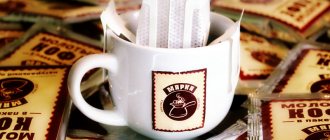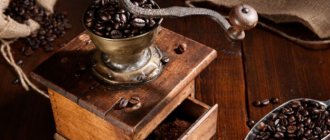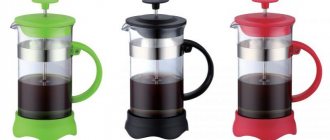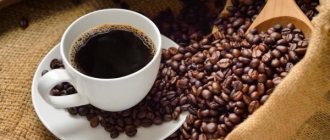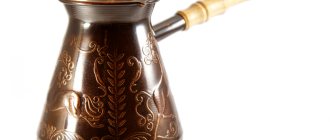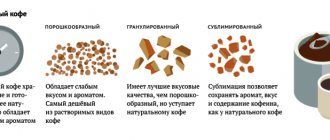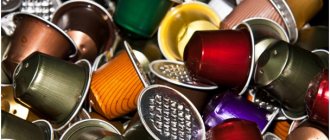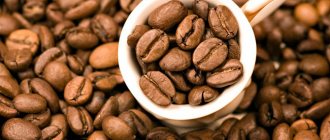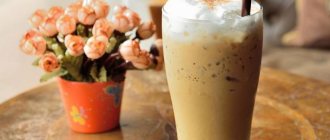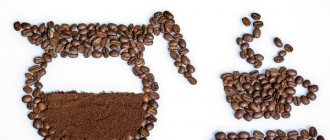Do you think that it’s impossible to come up with anything new when it comes to making coffee? Then we present to you a new product of recent seasons - pour-over. The word, which is unusual for our ears, has English roots. It comes from the phrase pour over, meaning “to pour from above.”
Pour over is a method of brewing coffee by pouring hot water through a special filter with ground powder . The same thing is sometimes called for dishes specially designed for this method of preparing a drink. Now let's talk about everything in order.
Enjoy your coffee!
And remember that there is always room for experimentation - try different grains, change the grind size, change the water temperature, or try putting a couple of ice cubes or frozen fruit slices in a cup, this will give the drink a special sweetness. Try an alternative recipe called Pour Over Coffee. Making coffee in the Hario V60 is similar to any other pour-over machine, such as a Chemex or Drip coffee maker, you will find their recipes in our articles.
Japanese method of brewing coffee
After coffee began to assert its rights more and more decisively in Asian markets, the Japanese began to think about their own method of preparing the drink. At the very beginning of the 20th century, a brewing method called strait . Its essence was a little like making tea. The ground coffee was poured over with a slow and steady stream of hot water. The biggest trick was to choose the optimal pressure and flow rate of boiling water. The stream should be very thin, it must be poured in a spiral, and the entire pouring procedure should take about 2 minutes.
It is not surprising that the Japanese themselves really liked this method. It is similar to the usual tea manipulations and allows you to concentrate on the process of preparing the drink. Such concentration is highly valued in Japanese philosophy and culture, as it helps to achieve a state of spiritual harmony.
For the time being, this method had fans only in the land of the rising sun. In the mid-50s, one manufacturing company took the idea on board and began producing special utensils for making pour-over coffee. The assortment quickly grew to several dozen items, and now every Japanese person could quickly and easily prepare their favorite drink.
Catering enterprises have actively begun to use such utensils. She attracted the attention of tourists. The British who witnessed this method were delighted and immediately dubbed it the coffee ceremony . Then a second, typically English name appeared - pour over . Its transliteration into Russian gave the term pourover, under which this method is gaining popularity in our country.
About five years ago, pour-over entered the States and won the hearts of curious Americans, traditionally partial to all sorts of exotic things.
Around the same time, pour over reached the European part of the continent and today it can be freely purchased in many coffee shops in our country.
How to brew coffee using pour over method
- Place the dripper on the cup.
- Then insert the filter bag.
- Heat the water. The optimal temperature for making coffee using the pour-over method is 92-95 degrees.
- Then slowly, in a spiral motion from the edges of the funnel to its middle, lightly moisten the filter.
- Place the required number of spoons of coffee into the moistened filter.
- Slowly pour hot water through the coffee, working from the edges to the middle.
- Remove the coffee filter and carefully remove the funnel from the container.
Your drink is ready!
Have you already tried coffee prepared according to the Japanese method?
Brew Guide: December Dripper and December Bottomless
December funnels are smart devices for making coffee. Brewing in them is simple and convenient. The design is thought out to the smallest detail so that we don’t worry about anything unnecessary and get maximum pleasure from the process.
The inventors of December are Yangming Lee and Nicholas Cho, coffee experts from South Korea, organizers of barista championships throughout Asia, members of the Specialty Coffee Association, professional roasters and true alternative brewing gurus. In 2021, these two progressive coffee geniuses have come up with a multi-flow funnel design that can satisfy their own professional brewing requirements and make life easier for pour-over drinkers around the world.
The project was launched under the working title “Sunshine on a Rainy December Day.” From this romantic allegory, more like a line from haiku, a completely brutal steel coffee-making device emerged, and the name was shortened to December Dripper. The inventors raised money for the project on the Kickstarter crowdfunding platform. Even significantly more than required - 389% of the declared amount. This once again confirms how desirable and necessary this device was for industry professionals.
Two years later, in 2021, at the international coffee exhibition in Seoul, the creators presented a new product - a ceramic funnel with the lower part removed, December Bottomless.
In the article we talk in detail about the features of both funnels, share recipes and tricks that will be useful when brewing.
Dripper December
The first funnel in history with several flow adjustment modes.
You can brew using the immersion method - just pour, wait and drain. Or it can be done by drops, in different ways: impulsively, evenly, whatever you like.
4 dripper modes:
- mode 0 - all holes at the bottom of the funnel are closed
- mode 1 - 4 holes open
- mode 2 - 8 holes open
- mode 3 - all 12 holes are open
Adjusting modes allows you to control the water flow rate without changing other parameters.
You can brew from 200 to 700 ml. Suitable for both those who like to experiment with recipes and those who appreciate simplicity - like brewing in a French press.
“Lazy way”
Immersion brewing method Take:
- Dripper December
- Branded wave filter December
- 20 grams of coffee per cup (300 ml) or 40 grams for a double serving (600 ml)
- Grind medium (like sugar) or coarse (the size of sea salt)
- Water temperature is about 94 °C (if you don’t have a thermometer, wait a couple of minutes after boiling)
- Scales (you can use simple kitchen scales)
Brew:
- December dripper on mode 0 – all holes are closed
- Place the funnel on the cup. We insert a paper filter, wet it, pour hot water to remove the papery taste and warm up the equipment. Drain the water from the cup.
- Place a cup with a funnel on the scale. We fall asleep with coffee. Reset the scales and start the timer
- Pour in the required amount of water depending on the setting and wait 2:30 minutes if the grind is medium, or 3 minutes if the grind is coarser.
- We switch the dripper to mode 4 - open all the holes. We wait until the entire drink is poured into the cup. Close the holes again to prevent drops from falling on the table, and remove the funnel
Enjoy!
Combined method
Strait + immersion
This recipe may seem complicated at first glance, but it is not. For your convenience, we have made both a detailed description and a brewing profile diagram.
For your convenience, we have made both a detailed description and a brewing profile diagram.
We will need:
- Dripper December
- Branded wave filter December
- 18g fresh coarse coffee (about the size of sea salt)
- 280 ml water temperature about 94 °C
- Scales
Brewing profile. Save it for yourself 
Step-by-step brewing recipe:
- Dripper in mode 0 – all holes are closed. Place the funnel on the cup. Insert a paper filter, wet it by pouring hot water to remove the papery taste. Drain the water from the cup.
- Place the cup with the funnel on the scale. We fall asleep with coffee. Reset the scales and start the timer
- 00:00 min - pre-wet 36 ml, wait 20 seconds
- Switch the funnel to mode 3, drain
- 00:30 min - close the holes, pour in 110 ml, wait
- 01:20 min - switch to mode 3, drain
- 02:00 min - close the holes, pour in another 80 ml
- 02:30 min - switch to mode 3, drain
- 03:10 min - close the holes, pour in another 60 ml
- We wait 20 seconds, open all the holes. When all the water has dripped, remove the funnel from the cup
Enjoy the taste of your favorite coffee!
Dripper December Bottomless
After a couple of years of enthusiastic use of December funnels, the creators noticed that they themselves and their friends around the world most often brew coffee on mode 4, when all the funnel holes are open. Then they decided to ease the efforts of their comrades and further expand the possibilities of straight brewing - and made a new funnel with the lower part of December Bottomless removed.
You can use different types of filters with the funnel: wave filters and filters for V60.
Depending on the shape of the filter, the “coffee tablet” is formed differently, and this changes the flavor bouquet.
There are no ribs inside the funnel, so the V60 type filter fits tightly to the walls. Thanks to this, the entire volume of the “coffee tablet” is used during the brewing process. This gives the most controlled and complete extraction - a balanced and voluminous taste
December Bottomless has lower walls than most drippers. This allows you to bring the teapot spout as close as possible to the surface of the coffee when pouring. Thus, the water jet does not create unnecessary turbulence and the coffee is brewed evenly and comprehensively
So let's start brewing!
For brewing with paper V-shaped filters, you can use the recipes for the V60 funnel.
IMPORTANT! Unlike the classic Hario or Tiamo funnels, the December Bottomless dripper has no ribs on the dripper walls. This prevents air circulation and the water takes a little longer to pass through the “coffee tablet”. Therefore, when preparing V60 recipes, we recommend using a slightly coarser grind, such as for a Chemex.
Recipe for brewing coffee in December Bottomless with a wave filter
We take:
- Funnel December Dripper Bottomless
- Wave filter December
- 18g fresh coarse coffee (about the size of sea salt)
- 280 ml of water at a temperature of about 94 °C (if you don’t have a thermometer, wait a couple of minutes after boiling)
- Scales (you can use simple kitchen scales)
Cooking:
- Place the funnel on the cup. We insert a paper filter, wet it, pour hot water to remove the papery taste and warm up the equipment. Drain the water from the cup
- Place a cup with a funnel on the scale. We fall asleep with coffee. Reset the scales and start the timer
- Pre-wet 36 ml, wait 30 seconds
- Pour in 110 ml of water, wait until all the water spills
- Pour in another 80 ml, wait for the water to drain
- Pour in another 60 ml, wait for the water to drain
- All the water has drained, we have done it in about 4 minutes, remove the funnel from the cup, let the drink cool slightly and breathe
- Finally, we sit back and enjoy the great taste of home-made coffee!
Useful tips
- If the taste is too acidic and acrid, reduce the grind. Or add more water.
- If there is a lot of bitterness in the taste, on the contrary, grind coarser. Or increase the bookmark.
- To get a stronger drink, add more coffee, and vice versa.
Using these recommendations, you will learn to control the taste of the drink and gradually understand the interdependence of the parameters. Don’t be afraid to deviate from the rules and experiment, this is the only way to find your favorite taste!
Drink coffee with love!
History of the pour over
Writer Ruth Brown, author of a book about coffee, notes that in the outback of American villages in the twentieth century they used funnels that resemble modern machines. However, the classic version of the pour-over was first invented in Japan. It was there that people resorted to the drip brewing method.
The name comes from a combination of two English words – pour and over, which literally translates as pouring from above. Despite the fact that the device was invented back in 1908, widespread distribution and popularity came only a hundred years later in the United States of America.
A few years later, this option for brewing coffee spread to Europe, along with the fashionable trend to consume only organic products and everything fresh. Pour-overs came into use with assembly line production from the Japanese brand Hario. Thanks to the name of the manufacturing company, the device received the name Hario.
This method of preparing a spicy drink is explained by the fact that pour-over is the only existing opportunity to brew coffee without losing its natural taste and value.
Pourover kettle and dripper
The main item for brewing pour-over coffee is a dripper (funnel). It is made of plastic, glass or ceramics. It is mounted on a regular cup. A paper filter bag for coffee powder is inserted into the funnel. First lightly moisten the filter with boiling water, and then begin pouring it through the coffee.
You can buy a mobile funnel separately or purchase a set that includes a teapot and a funnel.
The Japanese company Hario , specializing in the production of such cookware, offers a convenient pour-over kettle and funnel Hario V60 .
A distinctive feature of the teapot is its thin, very long, curved spout. It is located in the lower part of the body, which allows you to create the necessary pressure during brewing. The Japanese claim that with such a kettle, even a beginner will brew delicious coffee the first time. After all, the design of the spout allows you to create a stream of optimal pressure and speed. The range includes kettles designed for heating on the stove, as well as electric models.
The Hario V60 funnel looks like this
The manufacturer of pour-over cookware is so popular in Japan that the company's name is sometimes confused with the name of the coffee brewing method, mistakenly calling it Hario.
Hario is a manufacturer of cookware for the spill method. The method of brewing coffee is called pour over.
Dripper is the name of the funnel in which the filter is placed.
